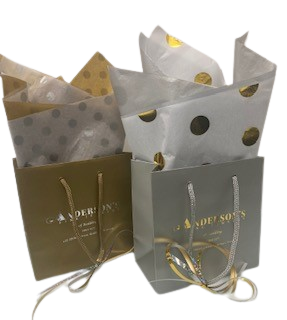
Become well-versed in key jewelry terms to ensure you’re properly equipped to begin your next shopping experience.
The jewelry business is full of terms that the average person may not be familiar with, which can cause confusion and uncertainty for customers trying to pick out the perfect piece. Learning jargon that’s often used in this industry will give you better insight to make smarter, savvier purchasing decisions. Here is some common terminology you’re likely to encounter when shopping for jewelry.
A Beginner’s Guide to Jewelry Lingo
- Alloy
This applies to jewelry that contains multiple metals fused together. Alloy helps strengthen the metal or change its color. White gold is one example since it’s made from a combination of gold, nickel, and zinc.
- Blemish
A blemish is any flaw or imperfection that’s found on the surface of a gemstone or diamond.
- CAD
Computer-aided design (CAD) is the use of computer software to help create or modify a jewelry design. This is frequently utilized for custom pieces.

- Carat
Not to be confused with karat, a carat is used to describe the weight of a diamond or gemstone. One carat equals 0.2 grams.
- Gold-Filled
Jewelry pieces that are gold-filled are made up of a base metal and coated in a thick layer of gold that bonds to the surface. It’s standard practice to use at least 10K gold.
- Inclusion
These are natural imperfections or abnormalities located in the interior of a gemstone or diamond. They consist of elements such as gases, minerals, or other substances and can vary greatly in severity.
- Lapidary
The term lapidary describes the process of cutting, shaping, polishing, and creating jewelry pieces from precious or semi-precious stones.
- Loupe
A loupe is a magnification tool jewelers use to evaluate the condition and value of a piece. Diamonds and color stones should always be analyzed at 10x magnification for the highest accuracy.

- Mounting
This is a metal setting that helps hold a stone in place.
- Plating
Jewelry plating is a method that involves permanently placing another metal coating onto the base metal of a piece. For instance, white gold is plated with rhodium to eliminate the yellow tint and achieve a whiter shade.
- Precious Metal
A precious metal is any naturally occurring metal that’s considered to have high monetary value. Usually, this refers to gold, silver, platinum, and palladium.
- Vermeil
Silver jewelry that’s been coated in a fine layer of gold is known as vermeil. The Federal Trade Commission allows this description to be applied only if the gold coating is at least 10k.
At Anderson’s Fine Jewelry in Redding, CA, we believe in educating each of our customers so they can make informed and successful jewelry investments. Our knowledgeable jeweler and staff members are available to enhance your industry understanding so you may buy with confidence. Call (530) 223-3443 to find out more about the extensive inventory we carry, or visit us online to start your shopping journey.



